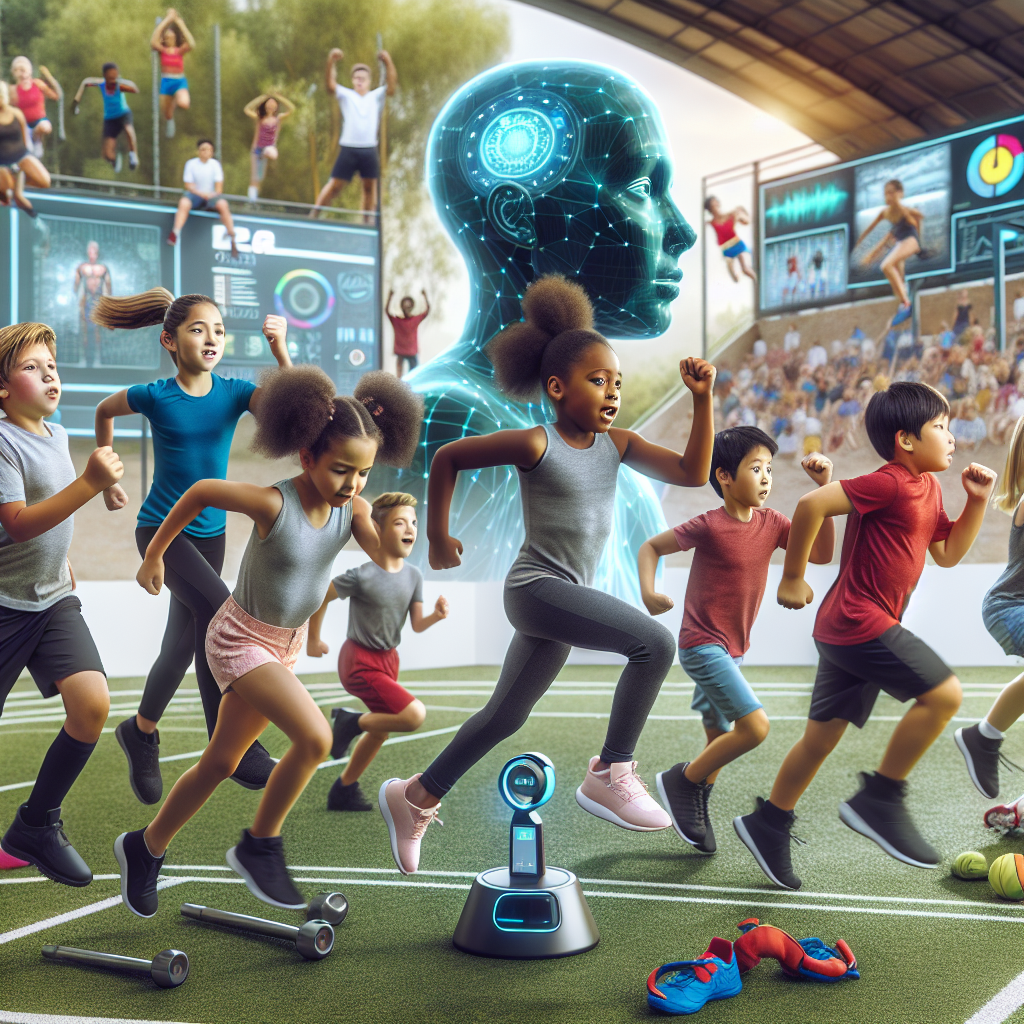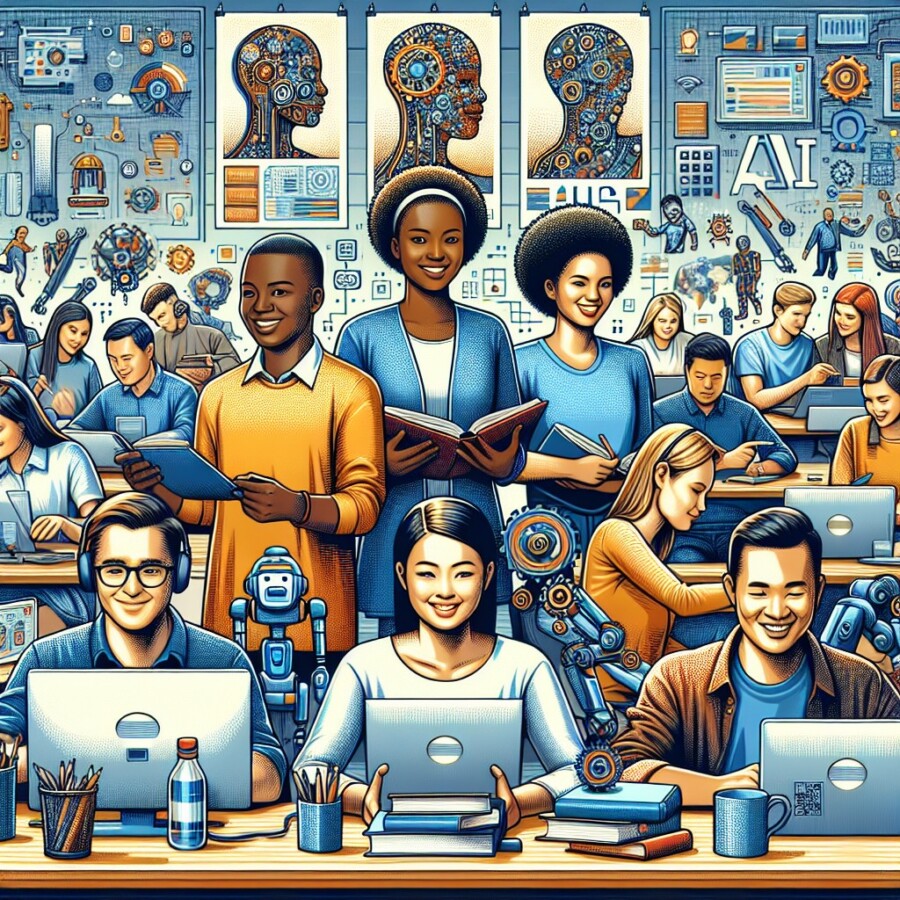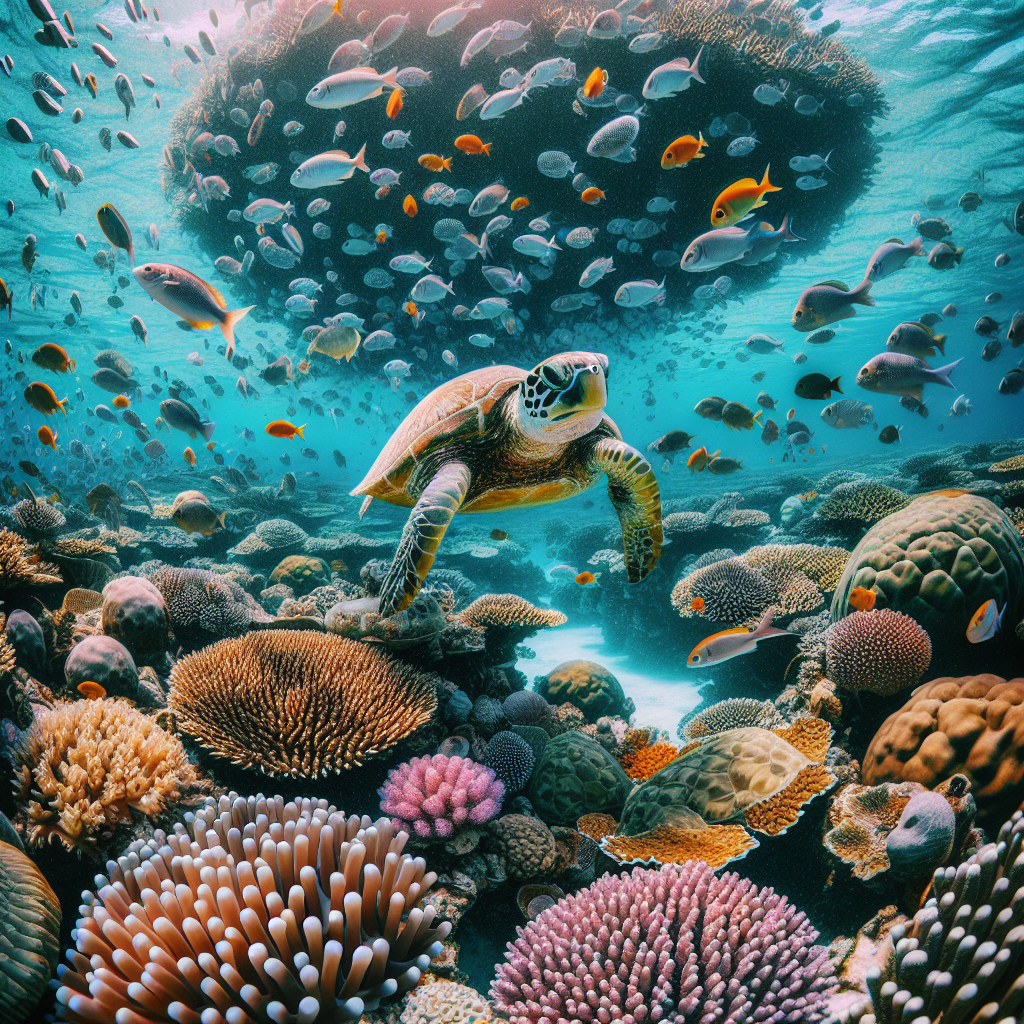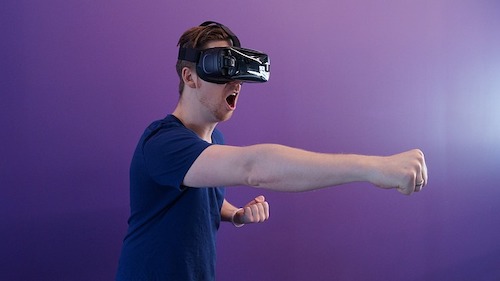At the Paris Olympics, a new AI system is being tested to find future Olympic champions. This cool technology is made to check how good young athletes might be in different sports. The people who created this system hope to make a smaller version that can be used in remote areas around the world, so that talent can be found no matter where someone lives.
During the tests, kids like Tacto and Tomo from Yokohama, Japan, take part in activities like running, jumping, and strength exercises. The system gathers information from these activities and analyzes it to look at things like power, endurance, and agility. By comparing these results to data from top athletes, the system can suggest which sport each kid might be best at. Sarah Vickers, who leads Intel’s Olympic Program, says this technology helps regular people see how they stack up against elite athletes.
The AI system being used in Paris also has a portable version that can work on phones and tablets. This makes it easier to assess performance without needing complicated equipment. Recently, the International Olympic Committee used this technology in Senegal, where they tested over 1,000 kids in different villages. They found 48 kids with great athletic potential and gave them chances to improve their skills.
While it’s exciting to find talent early, some experts, like Prof. John Brewer, warn that a simple assessment might miss important skills, especially for sports that need special techniques. He thinks the AI system is useful for initial checks, especially in places where advanced methods aren’t available. However, he believes this technology should be part of a bigger system to fully evaluate athletes. As the testing goes on at the Olympic Stadium, kids like Tacto are excited to be seen as potential sprinters, even if they like other sports right now.
Original news source: The AI tech aiming to identify future Olympians (BBC)
🎧 Listen:
Slow
Normal
Fast
📖 Vocabulary:
| 1 | endurance | The ability to keep going for a long time without getting tired |
| 2 | agility | The ability to move quickly and easily |
| 3 | potential | The possibility of becoming something in the future |
| 4 | assess | To judge or decide the value or quality of something |
| 5 | elite | The best or most skilled people in a group |
| 6 | portable | Easy to carry or move around |
| 7 | complicated | Hard to understand or deal with |
| 8 | techniques | Special ways of doing something |
| 9 | initial | Happening at the beginning |
| 10 | evaluate | To judge or calculate the quality, importance, or value of something |
| 11 | sprinters | People who run very fast in short races |
| 12 | remote | Far away from other places or people |
| 13 | analyze | To examine something in detail to understand it better |
| 14 | performance | How well someone does a task or activity |
| 15 | advanced | More developed or complex than others |
Group or Classroom Activities
Warm-up Activities:
– CHARADES
Instructions: Divide the class into small groups. Each group will take turns acting out key terms or concepts from the article without speaking, while the other groups guess what they are. Terms can include “AI system,” “Olympics,” “talent,” “athlete,” and “performance.”
– OPINION POLL
Instructions: Have students walk around the classroom and ask their classmates their opinions on the use of AI in sports. They should take notes on the responses and be prepared to share the most interesting opinions with the class.
– HEADLINE CREATION
Instructions: Ask students to come up with catchy headlines for the article. They should focus on summarizing the main points in a creative way. After they’ve written their headlines, have them share with the class and discuss which ones they think best capture the essence of the article.
– MIND MAP
Instructions: In small groups, have students create a mind map that illustrates the main ideas from the article. They should include aspects such as the AI technology, its purpose, benefits, potential drawbacks, and examples from the article. Each group will then present their mind map to the class.
– FUTURE PREDICTIONS
Instructions: In pairs, have students discuss and write down their predictions for how AI technology like the one mentioned in the article will change the future of sports and athlete development over the next decade. After they have made their predictions, ask a few pairs to share their thoughts with the class.
🤔 Comprehension Questions:
1. What is the main purpose of the AI system being tested at the Paris Olympics?
2. How does the AI system gather information about the young athletes?
3. Who is Sarah Vickers, and what role does she play in relation to the AI technology?
4. What are some of the activities that kids like Tacto and Tomo participate in during the tests?
5. Why is it important for the AI system to have a portable version that works on phones and tablets?
6. What did the International Olympic Committee discover when they tested kids in Senegal?
7. What concerns does Prof. John Brewer have about the AI system’s assessments?
8. How do kids like Tacto feel about being seen as potential sprinters, even if they enjoy other sports?
Go to answers ⇩
🎧✍️ Listen and Fill in the Gaps:
At the Paris Olympics, a new AI system is being tested to find future Olympic (1)______. This cool technology is made to check how good young athletes might be in different sports. The (2)______ who (3)______ this system hope to make a smaller version that can be used in remote areas around the world, so that talent can be found no matter where someone (4)______.
During the tests, kids like Tacto and Tomo from Yokohama, Japan, take part in activities like running, jumping, and (5)______ exercises. The system gathers (6)______ from these activities and analyzes it to look at things like (7)______, (8)______, and agility. By comparing these results to data from top athletes, the system can suggest which sport each kid might be best at. Sarah Vickers, who leads Intel’s Olympic Program, says this technology helps regular people see how they stack up against elite athletes.
The AI system being used in Paris also has a portable version that can work on (9)______ and (10)______. This makes it easier to assess performance without needing complicated equipment. Recently, the International Olympic Committee used this technology in (11)______, where they (12)______ over 1,000 kids in different villages. They found 48 kids with great athletic potential and gave them chances to improve their skills.
While it’s exciting to find talent early, some experts, like Prof. John Brewer, warn that a simple assessment might miss important skills, especially for sports that need special techniques. He (13)______ the AI system is useful for initial checks, especially in places where advanced methods aren’t available. However, he believes this technology should be part of a bigger system to fully evaluate athletes. As the (14)______ goes on at the Olympic Stadium, kids like Tacto are excited to be seen as potential (15)______, even if they like (16)______ sports right now.
Go to answers ⇩
💬 Discussion Questions:
Students can ask a partner these questions, or discuss them as a group.
1. What is your opinion about using AI to find future sports champions?
2. How would you feel if you were tested by an AI system to see which sport you might excel in?
3. Do you think it’s fair to judge young athletes based on a simple assessment? Why or why not?
4. What is a sport that you think requires special techniques, and why do you think those techniques are important?
5. How do you think technology can help improve sports training for young athletes?
6. Do you like the idea of using portable technology, like apps on phones, to assess athletic performance? Why or why not?
7. What is a sport that you enjoy, and do you think you would be good at it if tested by an AI system?
8. How would you feel if you found out you had great potential in a sport you never considered before?
9. Do you think that talent can be found in remote areas, or do you believe it’s mostly in big cities? Why?
10. What is your experience with sports training? Have you ever used technology to help you improve?
11. How do you think young athletes would react to being compared to elite athletes through an AI system?
12. Do you think finding talent early is important for young athletes? Why or why not?
13. What is a challenge you think young athletes face when trying to improve their skills?
14. How would you feel if a system told you to focus on a sport you didn’t enjoy?
15. Do you think the benefits of using AI in sports outweigh the potential risks? Why or why not?
Individual Activities
📖💭 Vocabulary Meanings:
Match each word to its meaning.
Words:
1. endurance
2. agility
3. potential
4. assess
5. elite
6. portable
7. complicated
8. techniques
9. initial
10. evaluate
11. sprinters
12. remote
13. analyze
14. performance
15. advanced
Meanings:
(A) To judge or calculate the quality, importance, or value of something
(B) To judge or decide the value or quality of something
(C) More developed or complex than others
(D) Special ways of doing something
(E) The ability to keep going for a long time without getting tired
(F) People who run very fast in short races
(G) Far away from other places or people
(H) How well someone does a task or activity
(I) Easy to carry or move around
(J) Hard to understand or deal with
(K) To examine something in detail to understand it better
(L) The possibility of becoming something in the future
(M) Happening at the beginning
(N) The ability to move quickly and easily
(O) The best or most skilled people in a group
Go to answers ⇩
🔡 Multiple Choice Questions:
1. What is the purpose of the new AI system being tested at the Paris Olympics?
(a) To identify future Olympic champions
(b) To create new sports
(c) To train coaches
(d) To organize events
2. Where are the young athletes participating in the tests from?
(a) Paris, France
(b) New York, USA
(c) Sydney, Australia
(d) Yokohama, Japan
3. What types of activities do the kids participate in during the tests?
(a) Swimming and cycling
(b) Running, jumping, and strength exercises
(c) Team sports like soccer and basketball
(d) Dance and gymnastics
4. What does the AI system analyze to determine which sport a kid might excel in?
(a) Age and height
(b) Popularity of the sport
(c) Power, endurance, and agility
(d) Social media presence
5. How did the International Olympic Committee use this technology recently?
(a) They tested over 1,000 kids in Senegal
(b) They trained coaches in Europe
(c) They organized a global competition
(d) They built new training facilities
6. What concern does Prof. John Brewer have about the AI system?
(a) It is too expensive to use
(b) It takes too long to analyze data
(c) It might miss important skills for certain sports
(d) It is not popular among athletes
7. What is one advantage of the portable version of the AI system?
(a) It requires no internet connection
(b) It is cheaper than the main system
(c) It can be used for all sports
(d) It can work on phones and tablets
8. How do kids like Tacto feel about being assessed by the AI system?
(a) Nervous about the results
(b) Excited to be seen as potential sprinters
(c) Indifferent to the testing
(d) Frustrated with the technology
Go to answers ⇩
🕵️ True or False Questions:
1. The technology aims to evaluate how well kids might perform in various sports by analyzing their physical activities.
2. Athletes like Tacto and Tomo from Yokohama, Japan, do not participate in activities such as running, jumping, and strength exercises during the tests.
3. There is no portable version of the AI system that can be used on phones and tablets, making it harder to assess athletic performance.
4. All experts, like Prof. John Brewer, agree that the AI system may overlook important skills needed for sports that require specific techniques.
5. A old AI system is not being tested at the Paris Olympics to identify future Olympic champions among young athletes.
6. The International Olympic Committee recently tested the AI technology in Senegal, identifying 48 kids with significant athletic potential.
7. Sarah Vickers, who is in charge of Intel’s Olympic Program, believes this technology allows everyday people to see how they compare to top athletes.
8. The AI system compares the performance data of young athletes to that of elite athletes to suggest which sports they may excel in.
Go to answers ⇩
📝 Write a Summary:
Write a summary of this news article in two sentences.
Check your writing now with the best free AI for English writing!
Writing Questions:
Answer the following questions. Write as much as you can for each answer.
Check your answers with our free English writing assistant!
1. How does the AI system help identify young athletes’ potential in different sports?
2. What activities do kids like Tacto and Tomo participate in during the tests?
3. Why is the portable version of the AI system important for assessing athletic performance?
4. What concerns does Prof. John Brewer have about using the AI system for evaluating athletes?
5. How did the International Olympic Committee use the AI technology in Senegal, and what was the outcome?
✅ Answers
🤔✅ Comprehension Question Answers:
1. What is the main purpose of the AI system being tested at the Paris Olympics?
The main purpose of the AI system is to identify young athletes who might become future Olympic champions by assessing their potential in different sports.
2. How does the AI system gather information about the young athletes?
The AI system gathers information by having the kids participate in activities like running, jumping, and strength exercises, and then analyzes their performance data.
3. Who is Sarah Vickers, and what role does she play in relation to the AI technology?
Sarah Vickers is the leader of Intel’s Olympic Program, and she plays a role in promoting the AI technology as a way for regular people to see how their athletic performance compares to elite athletes.
4. What are some of the activities that kids like Tacto and Tomo participate in during the tests?
Kids like Tacto and Tomo participate in activities such as running, jumping, and strength exercises during the tests.
5. Why is it important for the AI system to have a portable version that works on phones and tablets?
Having a portable version that works on phones and tablets is important because it makes it easier to assess performance without needing complicated equipment, allowing more people to access the technology.
6. What did the International Olympic Committee discover when they tested kids in Senegal?
When the International Olympic Committee tested kids in Senegal, they discovered 48 kids with great athletic potential and provided them with opportunities to improve their skills.
7. What concerns does Prof. John Brewer have about the AI system’s assessments?
Prof. John Brewer is concerned that a simple assessment might overlook important skills, especially in sports that require special techniques, and he believes the AI should be part of a more comprehensive evaluation system.
8. How do kids like Tacto feel about being seen as potential sprinters, even if they enjoy other sports?
Kids like Tacto feel excited about being seen as potential sprinters, even if they currently enjoy other sports, as it gives them a sense of recognition and opportunity.
Go back to questions ⇧
🎧✍️✅ Listen and Fill in the Gaps Answers:
(1) champions
(2) people
(3) created
(4) lives
(5) strength
(6) information
(7) power
(8) endurance
(9) phones
(10) tablets
(11) Senegal
(12) tested
(13) thinks
(14) testing
(15) sprinters
(16) other
Go back to questions ⇧
📖💭✅ Vocabulary Meanings Answers:
1. endurance
Answer: (E) The ability to keep going for a long time without getting tired
2. agility
Answer: (N) The ability to move quickly and easily
3. potential
Answer: (L) The possibility of becoming something in the future
4. assess
Answer: (B) To judge or decide the value or quality of something
5. elite
Answer: (O) The best or most skilled people in a group
6. portable
Answer: (I) Easy to carry or move around
7. complicated
Answer: (J) Hard to understand or deal with
8. techniques
Answer: (D) Special ways of doing something
9. initial
Answer: (M) Happening at the beginning
10. evaluate
Answer: (A) To judge or calculate the quality, importance, or value of something
11. sprinters
Answer: (F) People who run very fast in short races
12. remote
Answer: (G) Far away from other places or people
13. analyze
Answer: (K) To examine something in detail to understand it better
14. performance
Answer: (H) How well someone does a task or activity
15. advanced
Answer: (C) More developed or complex than others
Go back to questions ⇧
🔡✅ Multiple Choice Answers:
1. What is the purpose of the new AI system being tested at the Paris Olympics?
Answer: (a) To identify future Olympic champions
2. Where are the young athletes participating in the tests from?
Answer: (d) Yokohama, Japan
3. What types of activities do the kids participate in during the tests?
Answer: (b) Running, jumping, and strength exercises
4. What does the AI system analyze to determine which sport a kid might excel in?
Answer: (c) Power, endurance, and agility
5. How did the International Olympic Committee use this technology recently?
Answer: (a) They tested over 1,000 kids in Senegal
6. What concern does Prof. John Brewer have about the AI system?
Answer: (c) It might miss important skills for certain sports
7. What is one advantage of the portable version of the AI system?
Answer: (d) It can work on phones and tablets
8. How do kids like Tacto feel about being assessed by the AI system?
Answer: (b) Excited to be seen as potential sprinters
Go back to questions ⇧
🕵️✅ True or False Answers:
1. The technology aims to evaluate how well kids might perform in various sports by analyzing their physical activities. (Answer: True)
2. Athletes like Tacto and Tomo from Yokohama, Japan, do not participate in activities such as running, jumping, and strength exercises during the tests. (Answer: False)
3. There is no portable version of the AI system that can be used on phones and tablets, making it harder to assess athletic performance. (Answer: False)
4. All experts, like Prof. John Brewer, agree that the AI system may overlook important skills needed for sports that require specific techniques. (Answer: False)
5. A old AI system is not being tested at the Paris Olympics to identify future Olympic champions among young athletes. (Answer: False)
6. The International Olympic Committee recently tested the AI technology in Senegal, identifying 48 kids with significant athletic potential. (Answer: True)
7. Sarah Vickers, who is in charge of Intel’s Olympic Program, believes this technology allows everyday people to see how they compare to top athletes. (Answer: True)
8. The AI system compares the performance data of young athletes to that of elite athletes to suggest which sports they may excel in. (Answer: True)
Go back to questions ⇧













